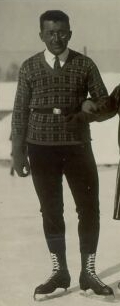Stanko Bloudek
Stank Bloudek (born February 11, 1890 in Idrija , Austria-Hungary , † November 26, 1959 in Ljubljana ) was a Yugoslav engineer, aviation pioneer and sports official.
resume
Stanko Bloudek was born on February 11, 1890, the son of a Czech mining engineer and a Slovenian mother in the Slovenian mining town of Idrija . He spent his youth in Most (Brüx) in Bohemia, where his father had been transferred as an official of the Austro-Hungarian mining administration. There he passed the Abitur in 1908. Bloudek then studied mechanical engineering in Prague.
Bloudek showed an early interest in aviation. As a high school student, he designed his first aircraft models. In addition to his studies, he then worked as a flight pioneer. In 1910 he presented his first aircraft, the monoplane "Racek" (Seagull). One year later, the next design followed with the "Libela" (dragonfly) biplane. For a while he also worked with the well-known aircraft manufacturer Igo Etrich . During the First World War, Stanko Bloudek was employed by the Hungarian Aircraft Works in Budapest.
After the end of the First World War, Bloudek moved to his mother's homeland, which now belonged to the newly formed Yugoslavia. There, too, he continued to manufacture aircraft. In 1922 he designed the sports aircraft "Sraka" (Elster). In 1930 he designed the two-seat monoplane "Lojze" - also known as "Bloudek XV" - which became the most important aircraft he built. After a fatal accident, Bloudek gave up aircraft construction and also shifted automotive development. The company he founded, "Avtomontaža", manufactured buses and passenger cars in the 1930s, most of which were licensed foreign models.
Since the 1920s, Stank Bloudek worked alongside his professional activity as an active athlete and sports official. As a figure skater, he was part of the Yugoslav team at the 1928 Winter Olympics in Sankt Moritz, but did not take part in the competition. After the end of his active career, Bloudek began to get involved in the construction and expansion of sports facilities. In 1934 the giant ski flying jump in Planica was built according to his plans . At the sports federation level, he was involved in founding the Yugoslav Olympic Committee in 1919. In 1948 he finally became a member of the IOC .
Stanko Bloudek died on November 26, 1959 in Ljubljana .
Appreciation
In the Slovenian capital Ljubljana, a memorial commemorates the "father of Slovenian winter sports". The most important Slovenian sports award also bears his name.
literature
- Marko Malec: Stanko Bloudek in njegova letala. Tehniška založba Slovenije, Ljubljana 2009, ISBN 978-961-251-175-3 .
Web links
- BLOUDEK, Stanko in the CESA project
| personal data | |
|---|---|
| SURNAME | Bloudek, Stanko |
| ALTERNATIVE NAMES | Bloudek, stank |
| BRIEF DESCRIPTION | Slovenian engineer, aviation pioneer and sports official |
| DATE OF BIRTH | February 11, 1890 |
| PLACE OF BIRTH | Idrija |
| DATE OF DEATH | November 26, 1959 |
| Place of death | Ljubljana |
